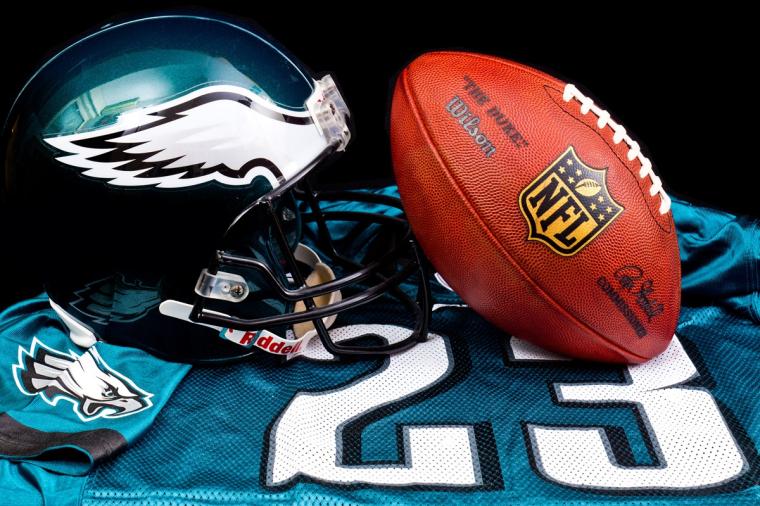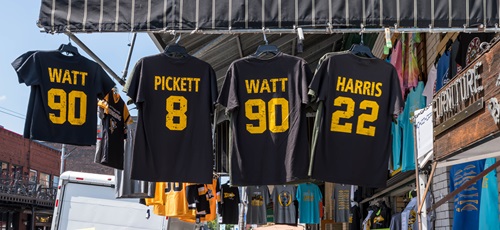
Super Bowl championship T-shirts, sweatshirts and hats celebrating the Philadelphia Eagles’ win in 2023. The Cincinnati Bengals’ victory in 2022. The Kansas City Chiefs’ championship in 2021. The San Francisco 49ers in 2020.
Either the apparel celebrating the 49ers' victory in two weeks, or that of the Chiefs.
Seeing a common thread for these fancy gameday threads? They all represent apparel that was made in advance to honor teams that didn’t wind up winning the Super Bowl.
So, what happens when thousands of items are produced but can’t be sold?
It turns out the NFL has a game plan. According to Sporting News, for the last 10 years, Virginia-based company Good360 has partnered with the league to make certain that unused items go to people in need. (They do the same with Major League Baseball, by the way).
The article notes, “This effort brings unused championship shirts and other merchandise to Africa, Asia, Eastern Europe, and the Middle East, and it includes the apparel of losing teams from the conference championship games as well.”
So yes, that means Bengals and 49ers conference championship gear will be headed to those in need, as well as merchandise proclaiming the Eagles as Super Bowl winners. Do the math and that means 50 percent of what is produced needs to be donated.
The approach works because production of apparel begins early. With a Super Bowl win (or a conference win, for that matter), time is of the essence for maximizing revenue when selling apparel. People want to buy merchandise online immediately (Hello, Amazon and QVC), or they want to walk into a store and get it on Monday morning.
Both scenarios mean items have to be ready to go in advance. If fans had to wait weeks for championship clothing to be produced and shipped, the demand would die back, along with sales. If sellers have apparel for both Super Bowl teams on hand prior to the big game, they only need to pull out the items celebrating the winner and start ringing up the sales. And since the merchandise that becomes available first is the quickest to produce in large quantities (T-shirts, hats and sweatshirts), it costs less to produce it in advance than it does to lose out on sales because those items weren't in stock when people wanted them. (More specialized items, like socks, Christmas sweaters, even commemorative jerseys, go into production as soon as the game ends).
And that’s where Good360 comes in, says USA TODAY: “The process begins well before we find out who will be playing in the Super Bowl. The NFL and Good360 work together to come up with a list of countries where things could be sent, mostly in Africa, the Middle East, Asia and South America. After a list is approved, Good360 then reaches out to its non-profit partners in those countries to see which places are most in need. Once the Super Bowl is over, the NFL then gives retailers instructions on what to do with the losing team's apparel. All of the items are then sent to one location in the United States.”
 “These goods have to leave the United States,” Good360’s marketing officer Shari Rudolph told USA TODAY. “The NFL and the teams themselves don't want to have it here in the country and finding their way back into consumers' hands, probably for all the obvious reasons.”
“These goods have to leave the United States,” Good360’s marketing officer Shari Rudolph told USA TODAY. “The NFL and the teams themselves don't want to have it here in the country and finding their way back into consumers' hands, probably for all the obvious reasons.”
It therefore calls for a certain strategy, Rudolph told USA TODAY reporters, since “maintaining the entire operation's secrecy is critical, as it can take a few weeks, possibly months, to get everything to one spot and send it out. Good360 waits to ship until containers can be completely filled.”
And yes, while having a shirt with the wrong winner on it sounds like a great joke, the reality is that where such clothing is headed, it can make a significant difference to quality of life. Clean, well-made and wearable clothing, like sweatshirts or T-shirts, is something many people do not have – and new clothing (yes, including items printed with sports teams’ logos) is a luxury.
Sporting News says that Good360 has “stringent compliance protocols” that prevent donated items from ending up on the market and in the hands of anyone else.
“Good360 will work closely with international NGOs to ensure that the apparel goes directly into the hands of the right communities—and not some place where someone might be able to profit from it,” Rudolph told reporters at The Hill. “We also take pains to avoid sending the apparel to a location where a flood of donated clothing could disrupt the local economy.”
Information on Good360’s relationship with the NFL can be found here.
Mental Floss said this is not the NFL’s first partnership to donate goods: “Good360 took over the NFL’s excess goods distribution in 2015. For almost two decades prior, an international humanitarian aid group called World Vision collected the unwanted items for MLB and NFL runners-up at its distribution center in Pittsburgh, then shipped them overseas to people living in disaster areas and impoverished nations. After losing Super Bowl XLIII in 2009, Arizona Cardinals gear was sent to children and families in El Salvador. In 2010, after the New Orleans Saints defeated Indianapolis, the Colts gear printed up for Super Bowl XLIV was sent to earthquake-ravaged Haiti.”
Another advantage of donating unusable clothing is the fact that it does not go into a landfill. And that, plus benefitting those in need, winds up being a win after all – no matter who takes home the Vince Lombardi Trophy.
But as for the champagne that winds up in both teams' locker rooms...well, that is its own sad story. One can only hope it is removed (and quickly) from the losing team's area after the final play.

